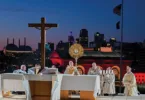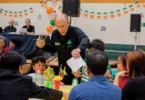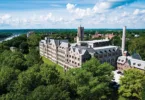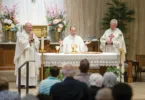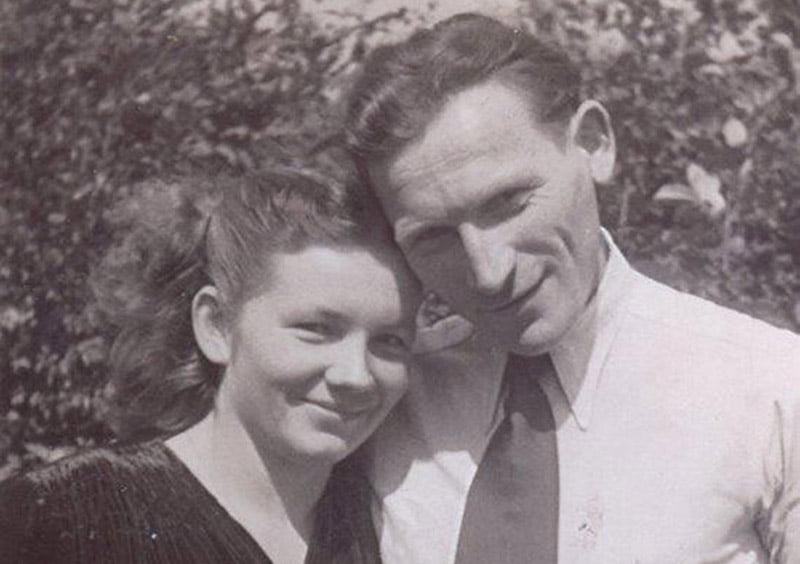
Laura Rzepczyk’s story is one OF LOVE, NAZIS, AND A HOLY ICON. IT’S A STORY SO FANTASTIC . . . IT HAD TO BE TOLD
by Jill Ragar Esfeld
jill.esfeld@theleaven.org
OVERLAND PARK – When Holy Spirit parishioner Laura Rzepczyk died at the age of 91, she had only her daughter to mourn her.
But at her funeral a few days later, more than 400 people showed up to celebrate her life.
It’s not unusual for a Holy Spirit funeral to be well attended; pastor Father Rick Storey often invites parishioners to come in support of small families.
“I encourage people to do it as a corporal work of mercy,” he said.
But that usually means an additional 100 or 150 people, at best.
“[The turnout] was kind of a miracle,” said parishioner Reba Miller. “We usually have a good turnout.
“But not like that.”
Those who came heard Father Storey’s account of Laura’s life.
It was the story of a humble Polish immigrant — with a heart full of only love and forgiveness in the face of immeasurable suffering.
“Her passion, love and her commitment to her faith were just amazing,” he said. “She was never bitter, never scarred.
“She never uttered anything but kindness to people.”
As Laura’s story unfolded, an atmosphere of awe-filled inspiration fell over the church.
“I never met her,” said parishioner Janet Goodwin. “I just know of her from the story, and it just grabbed me so.
“There are simple, humble people among us who are saints.”
So touched was the congregation by this devout woman’s life, that by the time its members were exchanging the sign of peace, everyone was crying.
“I can honestly say, there were no dry eyes,” said Goodwin. “And it wasn’t just older people there — there were people of all ages.”
When the service was over, everyone agreed.
Laura’s story had to be told.
Pilgrimage to Czestochowa
Laura was born and raised in a small village outside the town of Czestochowa, Poland — home to an icon called the Black Madonna.
Also known as Our Lady of Czestochowa, legend attributes the painting of the icon to St. Luke.
“There was a tradition in Mom’s home,” said her daughter Christina. “As each child reached adulthood, my grandfather would take that child on a pilgrimage, by foot, to the cathedral to see the Madonna.”
Laura was the middle of 11 children.
In 1942, at the age of 19, it was her turn to make the pilgrimage with her father.
But that journey would never take place. Nazi troops, which occupied Poland at the time, seized the family’s farm and prepared to transport Laura’s father to Germany for forced labor.
Feeling only concern for her mother and siblings, Laura stepped forward and said, “Take me instead.”
“They took her,” said Christina simply.
Like so many others before and after her, Laura then boarded a train bound for a work camp.
“The train she was on — a cattle car — had a little opening where she could see outside,” said Christina.
And the train made a stop in a town known to her.
“They went through the town of Czestochowa,” said Christina. “And my mom [could] see the cathedral out of that little opening.”
Years later, Christina would ask her mother if she was scared during that trip.
“Of course, the way things were happening, it was very, very fearful,” Christina remembered her mother telling her. “But when she looked through that opening and saw the cathedral, she said she knew things were going to turn out all right.”
From that moment on, Laura had a burning desire to see the icon of Our Lady of Czestochowa.
Much would happen before that dream would come true.
Prisoner of war
In the labor camps, Poles were viewed as inferior by the Nazis and singled out for some of the harshest treatment.
For three years, Laura was sent to hard labor on a farm camp.
Suffering starvation, exhaustion and exposure, she held onto her Catholic faith and her devotion to the Black Madonna through silent prayer.
Not far from Laura, her future husband Michael was suffering a similar fate.
“My dad was in the Polish army,” said Christina. “He was captured by the Nazis and spent seven years as a prisoner of war in Germany.
“They had it tough in both situations.”
When the war ended, Laura and Michael were shuffled through various displaced persons camps in Germany.
In 1946, they met through a mutual friend and decided to marry.
A year later, Christina was born.
“My dad was working when they met, so he had bought a bicycle,” said Christina. “He traded that bicycle for an American soldier’s parachute, and my mother made her wedding dress out of it.
“Later, she lined my baby bed with it.”
Laura and Michael, now with a child’s future in their hands, faced a new dilemma — whether they should go back home to Poland or start a new life elsewhere.
Coming to America Both Rzepczyks came from large families they missed very much.
But letters from home were discouraging.
“Because Russia had gotten protectorate over Poland,” said Christina, “Mom and Dad were getting letters saying, ‘Don’t come back. The uniforms have changed, but the situation is the same. “‘Go where you can be free.’”
Through the National Catholic Welfare Conference, the Rzepczyks were offered an opportunity to relocate to the United States.
“We boarded an American battleship,” said Christina, who was 4 when the family immigrated, and made for the United States.
Shortly after departure, a huge storm developed on the ocean and the captain decided the ship was too heavy to continue — that it would surely sink in the storm.
He gathered all the passengers together and told them, “You have two choices: You can go back and drop some people off, or you can throw everything you have overboard.”
The immigrants couldn’t bear to leave anyone behind.
They agreed instead to give up everything they owned.
“I was only 4,” said Christina. “But I remember all the suitcases, all the possessions and clothes, everything thrown overboard.
“And everybody crying.
“We literally arrived [in New York] with the clothes on our backs.”
They arrived on Armistice Day and found the port of entry closed for the holiday.
Worse yet, the ship had run out of food supplies.
Speaking only Polish, Michael took it upon himself to go into the streets of New York and beg for food for the children.
He managed to feed everyone on the ship.
“That was my dad,” said Christina.
Westward bound
In 1951, when the Rzepczyks arrived in America, there was a surplus of manufacturing jobs in the Midwest and not enough workers to man the factories.
A young Polish doctor in the Kansas City area had decided to honor his deceased parents by sponsoring Polish immigrants to the region.
With his help, the Rzepczyk family relocated to Our Lady of Peace Parish in Kansas City, Missouri, where Michael and Laura were devout, active parishioners for 50 years.
All who met them were amazed at their forgiving nature and generous spirit.
“I was their pastor from ’87 to ’91,” said Father James Taranto, currently pastor of St. Mark Parish in Independence, Missouri. “You would never know the hardships they experienced in their lives.”
At Laura’s funeral, Father Storey made the point that if anyone had a right to be bitter and angry, it was the Rzepczyks.
Yet Laura is remembered for often saying, “Not all the German people are bad — just some.
“And I pray for them.”
“They never saw their antagonists put on trial or receive any kind of punishment for what they did,” said Father Taranto. “No justice. “And yet they were loving, forgiving people.”
Beyond forgiveness, the couple was known for their active participation in their church community and their generous spirit toward anyone in need.
“I think the saddest thing for both of them was not being able to have their families [near],” said Christina. “I think that’s why they extended themselves to so many people.
“They made everybody their family.”
Never lose hope
As the years passed, Laura continued her devotion to Our Lady of Czestochowa and held on to the hope that she would see the icon some day.
Finances, however, only allowed her one trip back to Poland when she and Michael went to meet each other’s families in 1975.
At that time, travel restrictions and strict religious suppression enforced by the communist regime made it impossible for her to visit Our Lady of Czestochowa.
“They just never had another chance to go back after that,” said Christina.
In 2003, Michael and Laura moved to live with Christina in Overland Park and became members of Holy Spirit Parish.
“I remember when they would come to Mass, they always wore the color of the vestments,” said Denise Slaven, Holy Spirit music liturgy coordinator.
“That was tradition coming from Poland,” said Christina.
“I recall seeing them in Mass,” said Miller. “They were tiny, little people.
But after hearing their story, I realized they were strong, powerful people.”
On July 25, 2012, at the age of 95, Michael passed away.
Laura relied on her deep faith and devotion to Our Lady for the strength to go on without her life partner.
The Blessed Virgin must have heard Laura’s prayers, because, that same summer, a group of Catholics in Eastern Europe began a global campaign in support of life under the patronage of Our Lady of Czestochowa.
A magnificent replica of the original Black Madonna icon was blessed by the archbishop of Czestochowa and began a worldwide pilgrimage called the From Ocean to Ocean Campaign in Defense of Life.
The Black Madonna, at last
On June 24, the traveling icon came to the Archdiocese of Kansas City in Kansas, where a Mass and reception were held at Laura’s home parish.
She got to see her Madonna at last.
“And she said, she didn’t get to see the Madonna in Czestochowa,” recalled Christina, “so the Madonna came to see her in Overland Park.”
“When Laura saw the icon,” said Father Storey, “she said, ‘It’s going to be all right’ — just like she said on the train when she was taken prisoner.
“And that’s the last Mass she went to.”
Shortly after seeing the icon, Laura suffered a stroke.
“My mother died on July 25 — the same day as my dad, exactly two years later,” said Christina.
At Laura’s funeral, Slaven remembers the choir getting ready to sing the Lamb of God, then having to wait because Christina was still extending the sign of peace to the overwhelming crowd.
“She just went to every row and thanked every person,” she said. “She hugged every person — went down the aisles and around.
“There was just so much love; everyone was crying in church because it was just so beautiful how touched she was that everybody had come.”
Christina said she was simply doing what her mother would have done — welcoming everybody there.
“My mother was not didactic in any way,” she said. “She just lived her faith every day — like breathing.
“She didn’t think about it. It was just part of her.”
“Maybe Laura was not known by Hollywood standards,” said Father Storey, reflecting on her life, “but this woman made a huge difference in the world. “She was that powerful in her silent living.”

